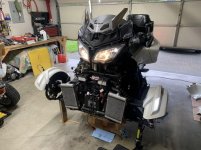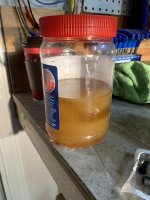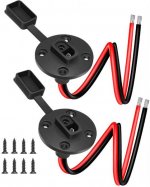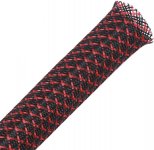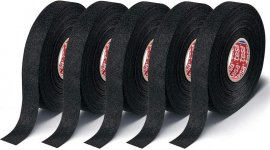Rednaxs60
New member
Today was not a riding day, could have been, but damp, a bit of drizzle - good working weather/day.
Took the front off. Anyone owning one of these 2014 to 2019 RT LE should do this at least once. Made the coolant flush easier. Coolant flush done. Had the engine running to operating temp twice, will check coolant level in the morning.
The service manuals do not mention everything regarding the removal of the front trunk. Had to disconnect the air intake.
Put the Spyder on the Big Blue (BB) Lift, blocked the bike front/back - side to side. Installed Speedbleeders, have used before and these are the cat's pajamas. Had to lower the BB to get at the brake pedal for the manual flush/bleed. The Speedbleeder for the VCM needs to be tight, took a bit of wrenching to get it to stop leaking past. Took a picture of the old brake fluid - it was time to change.
Tomorrow will hook up the B.U.D.S. for the first time, and do the brakes according to B.U.D.S.. Don't quite understand the procedure for the VCM module, but will be looking online for some guidance.
Intend to take off the front drive belt pulley - clean, lubricate, put back together. Have a new bolt if needed. Have front Centramatic balancers coming, as are M2 shocks - front/rear. Have been thinking about what electronics and accessory outlets I want to install and where these should go.
I've attached a picture of my Spyder with the front removed, and the old brake fluid - supposed to be clear.
Took the front off. Anyone owning one of these 2014 to 2019 RT LE should do this at least once. Made the coolant flush easier. Coolant flush done. Had the engine running to operating temp twice, will check coolant level in the morning.
The service manuals do not mention everything regarding the removal of the front trunk. Had to disconnect the air intake.
Put the Spyder on the Big Blue (BB) Lift, blocked the bike front/back - side to side. Installed Speedbleeders, have used before and these are the cat's pajamas. Had to lower the BB to get at the brake pedal for the manual flush/bleed. The Speedbleeder for the VCM needs to be tight, took a bit of wrenching to get it to stop leaking past. Took a picture of the old brake fluid - it was time to change.
Tomorrow will hook up the B.U.D.S. for the first time, and do the brakes according to B.U.D.S.. Don't quite understand the procedure for the VCM module, but will be looking online for some guidance.
Intend to take off the front drive belt pulley - clean, lubricate, put back together. Have a new bolt if needed. Have front Centramatic balancers coming, as are M2 shocks - front/rear. Have been thinking about what electronics and accessory outlets I want to install and where these should go.
I've attached a picture of my Spyder with the front removed, and the old brake fluid - supposed to be clear.

